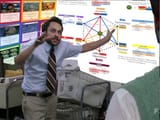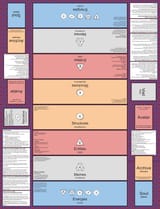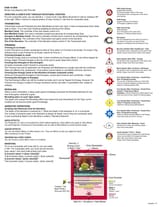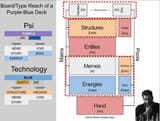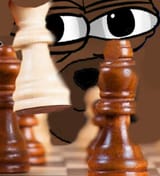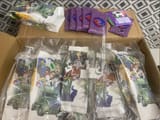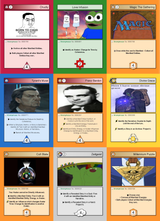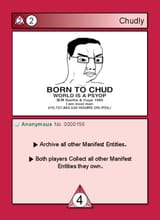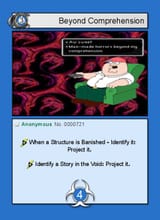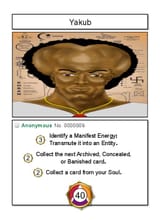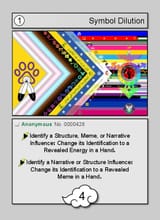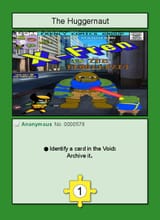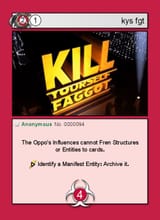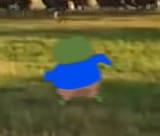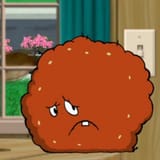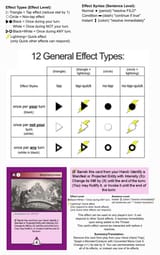Frenopolis General #5 - Pepe Silvia Edition
https://www.youtube.com/watch?v=_nTpsv9PNqo
Frenopolis is an open source gamified microcosm where players seek to outmaneuver each other to control the elements which comprise the world.
It is easiest to learn with any YGO/MTG experience.
It's not for sale, but you can request a free physical 2-player/6-pack/9-card draft-collecter-starter box by following the instructions in description of this video:
https://youtu.be/oPoBUoagO_k
(no identifying or payment information required)
Tabletop Simulator demo implementation:
(let me know if you'd like to set up a game)
https://steamcommunity.com/sharedfiles/filedetails/?id=3532880446
Physical Demo 1:
https://www.youtube.com/watch?v=W4Q_JRqjd_Y
Physical Demo 2:
https://youtu.be/KIGdAsFzgHI
More infos:
https://t.me/Frenopolis
Previous Threads:
>>96367444
>>96417964
Anonymous
9/2/2025, 1:11:11 AM
No.96450430
[Report]
>>96450424 (OP)
Picrel is a starter playmat which has all the zones and basic rules/definition/mechanic reminders.
It is 30*22inches, 2 inches longer than MTG starter playmats which serve the same function.
Between this playmat, and the 1 page condensed rules, you can play the game at an advanced level.
You can get this playmat printed/laminated at Office Depot for around $50, or for $7-15 if you use Banner Buzz (vinyl). You can get the high res .pdf files from the Telegram:
https://t.me/Frenopolis/20
Anonymous
9/2/2025, 1:27:00 AM
No.96450566
[Report]
Here is a quick reference sheet that covers the more advanced interactions. It is 8.5*11inches (single side).
Between the starter playmat, and this quick reference page, you can play at an advanced level.
The basic rules/mechanics of Frenopolis are generalized and simple. The ordering of them is what determines skill.
Check out a play through video:
Physical Demo 1:
https://youtu.be/KIGdAsFzgHI
Physical Demo 2:
https://www.youtube.com/watch?v=W4Q_JRqjd_Y
Anonymous
9/2/2025, 1:36:22 AM
No.96450656
[Report]
>>96498409
The 4 colors that make up the Frenopolis board are called "elements":
Fire, Air, Water, and Earth
All the board zones and card types are assigned 1 of these 4 elements.
Each card color (Red, Orange, Yellow, Blue, Purple, Violet) are defined as 2-combinations of the elements which comprise the board and the card types.
Defining all effects in terms of these elemental relationships allows a strict correspondence between the game board and color pie. The effect scope of each color is strictly defined and predictable.
You don't need to know this to play – you can just follow the written card text, but knowledge of the underlying design allows for more advantageous play.
Anonymous
9/2/2025, 2:02:52 AM
No.96450886
[Report]
>>96498409
For example:
A Purple (Psi) and Blue (Technology) deck will have a strictly predefined interaction scope:
Purple [Psi] (Air/Water) have effects which involve:
Memes (Air), Stories (Air), and Energies (Water)
in/to/from the:
Void (Air), Soul (Water), and Matrix (field)
Blue [Technology] (Air/Earth) have effects which involve:
Memes (Air), Stories (Air), and Structures (Earth)
in/to/from the:
Void (Air), Archive (Earth), and Matrix (field)
Purple (Air/Water) and Blue (Air/Earth) have an elemental conjunction (overlap) in the Air element. This means that a Purple/Blue deck will have effects which involve:
Memes (Air), Stories (Air), Energies (Water) and Structures (Earth)
in/to/from the:
Void (Air), Soul (Water), Archive (Earth), and Matrix (field)
Anonymous
9/2/2025, 2:03:53 AM
No.96450892
[Report]
How to understand Frenopolis in the context of Chess:
A chess board is composed of 2 colors (black and white) and 6 unique pieces (king, queen, rook, bishop, knight, and pawn).
The identity of each piece is characterized by its unique movement on the board. For example:
Pawn: Moves 1 square forward
Knight: Moves 2 then 1 perpendicular
Bishop: Moves diagonally on its color.
Rook: Moves horizontally.
King: Moves in 1 in any direction.
Queen: Moves diagonally or horizontally.
If you were to assign each of these movements an identifier (abstract them), you would end up with something like this:
Pawn: Move 1 square forward = P
Knight: Move 2 then 1 perpendicular = N
Bishop: Move diagonally on its color. = B
Rook: Move horizontally. = R
King: Move 1 in any direction. = K
Queen: Move diagonally or horizontally. = Q
In this way, you could define the Queen's movement (moves diagonally or horizontally) as:
>Queen = Moves horizontally (Rook “R”) + Moves diagonally on its color (Bishop “B”)
>Queen = Rook + Bishop
Queen = R + B
If you understand how a Chess piece's movement can be abstracted from the piece, you can understand how Frenopolis is constructed.
Anonymous
9/2/2025, 3:33:01 AM
No.96451669
[Report]
Frenopolis is like Chess, except the board has 4 colors instead of 2, and only 10 squares instead of 64. All of the movements between those 4 squares are abstracted (ex Pawn: Moves 1 square forward = P) and distributed onto cards. There are tables that serialize every single movement between every color. These movements are mixed and matched to create Frenopolis cards.
A chess example of this:
Pawn: Moves 1 square forward = P
Knight: Moves 2 then 1 perpendicular = N
Pawn-Knight = P + N
This meta piece “Pawn-Knight” is able to do both the actions of a Pawn and a Knight, in a single piece. Sort of like how a Queen is a combination of a Rook and Bishop. The movements are abstracted and combined to form a new piece.
Frenopolis cards are analogous to meta chess pieces on 4-color 10-square board. Once you learn the basic movements, it is easy to understand any card.
Anonymous
9/2/2025, 4:15:46 AM
No.96452022
[Report]
picrel is a box of starter/playtesting sets.
They each contain 6 packs of 15 cards each.
Each pack contains:
11 of a single color (all 6 packs are the same mono color)
2 Frens (green)
1 Story (grey)
0-1 Colorless (black)
0-1 Avatars (white)
Each of these kits contain 90 cards, and exactly 1/2 of a full color. There are 6 basic colors, so 12 sets total. There is no randomization or repeats. If you were to get all 12 kits, you'd have a complete 1080 card set.
To play with these starter sets, all you need to do is remove the white cards (avatars), then shuffle the cards together, and split the pile in half.
Then you need to select 1 of the removed avatars for each of the 2 players.
After that you can begin playing.
Question, where did the inspiration for this come from?
Anonymous
9/2/2025, 4:36:49 AM
No.96452156
[Report]
>>96452201
Anonymous
9/2/2025, 4:42:04 AM
No.96452201
[Report]
Hey wait, isn't "fren" a /pol/tard meme?
Anonymous
9/2/2025, 4:44:38 AM
No.96452237
[Report]
>>96452218
it could be a coincidence
Anonymous
9/2/2025, 4:47:11 AM
No.96452258
[Report]
>>96452218
Far Right Ethno-Nationalist
Anonymous
9/2/2025, 4:57:54 AM
No.96452365
[Report]
There are 7 card types in Frenopolis. A card's type is indicated by the symbol on the bottom of the card which contains its stat. There are no subtypes.
They are:
1.) Entity (like creatures or monsters)
2.) Structure (like artifact-sorcery-walls or perma defense mode monsters)
3.) Meme (like instant sorceries or trap cards)
4.) Story (like a field spell)
Entities, Structures, Memes, and Stories only differ in their Type designation and how they conduct combat.
For example:
Structures do not conduct combat at all.
Stories +1 cards.
Memes -1 cards.
Entities subtract their stat from their target.
5.) Energy (like mana)
6.) Avatar (like a commander)
7.) Fren (like a xyz monster)
These comparisons are rough and simplified, and I will explain them each in more detail below.
Anonymous
9/2/2025, 8:29:00 AM
No.96453396
[Report]
Entities:
Entities are the primary damage dealer in the game. In MTG terms, they have Haste, Trample, and Vigilance by default.
Entities are vulnerable to other Entities because the other Entity only need to have 1 stat higher to remove it through combat.
Entity's effects are usually tap effects. Tap in Frenopolis means "reduce stat by 1" (it also has a 90 degree rotation, but it can be repeated 4 times before returning to its original position because the cards have 4 stat). This means that to use an Entity effect, you have to make it weaker, and it makes it especially vulnerable to other Entities which all have a base stat of 4. In this way Entity effects are expensive and high risk.
The combat operation for Entity vs Entity is:
Reduce each Entity's Will from the other until the end of the combat phase, and subtract any difference from the player who controls the lower stat card.
Entities also have a more difficult time against Structures. The combat equation for Entity (Will) vs Structure (Equilibrium) is:
(Will - Equilibrium) +1
Because all the basic card types have 4 stat, this means it would take an Entity (with 4 stat) 3 turns to get through a single Structure (with 4 stat).
Example:
On the first attack the Entity would do 1 damage: (4 Will - 4 Equilibrium) + 1 = 1 damage, resulting in a 3 stat Structure.
On the second attack the Entity would do 2 damage (4 Will - 3 Equilibrium) + 1 = 2 damage, resulting in a 1 stat Structure.
On the third attack the Entity would do 4 damage (4 Will - 1 Equilibrium) + 1 = 4 damage,
resulting in a -3 stat Structure. Cards are removed when they reach 0 stat.
Entities cannot attack other player's Entities if they control any Structures. The Structures must be removed first.
Entities cannot conduct combat against Memes.
You choose the targets for all attacks, like YGO.
Anonymous
9/2/2025, 9:40:44 AM
No.96453634
[Report]
>>96452218
Take a look at that guys youtube channel anon.
Anonymous
9/3/2025, 1:26:05 AM
No.96460265
[Report]
>>96470107
Memes:
Memes are your primary ranged damage and fast/expensive effect output. Memes can be played on any player's turn (the rarespawn symbol on the Energy cost), like a MTG instant.
Meme effects are generally once per EITHER player's turn, and Quick. This effectively doubles their effect output relative to other cards. Quick means that their effects can only be responded to by other Quick effects. This is like spell speed 3 in yugioh.
Memes cannot be attacked, except by other Memes.
Memes do not protect your Avatar from being attacked.
They are like a spell/trap/sorcery that has a specialized mode of combat.
Meme Combat:
Memes have 2 options for combat. They can:
1.) -1 (tap) any card on the field.
2.) Reduce the Meme's stat (Virulence) by X, then reduce the stat of any card on the field by X.
These options are mutually exclusive - you can only choose one.
Memes are especially useful for strategically sniping cards out of reach, such as reducing an expensive Entity's stat (Will) by 1, making it vulnerable to even the cheapest Entity. Because a card's combat, health, and effect output power are combined into 1 stat, reducing a card's stat reduces all of those things.
When you build powerful Memes, you can remove complete cards in one hit.
Anonymous
9/3/2025, 8:55:20 AM
No.96462454
[Report]
Energies:
Energies function similarly to MTG mana, but there are no dedicated Energy cards. Energies are any card you play upside down from your hand into the Energy zone.
Energies do not conduct combat.
Energies can be used to pay for cards and energize your Avatar, giving access to powerful Avatar effects.
Cards give Energy color corresponding to their color. So a Blue card gives Blue Energy. A Green card (a fren) gives Green energy.
Energy removal is one of the most expensive and restricted effects in the game.
Transmutation of Energies is one of the most powerful effects in the game, because it allows you to play (invert/turn right side up) an Energy from your Energy zone. You basically get a free card at the cost of an Energy. See more on Transmutation.
Anonymous
9/3/2025, 10:42:49 AM
No.96462735
[Report]
Avatars:
Avatars are similar to MTG commanders, but they are not cast into the battlefield, and they set your Time (life) for the game. Avatars can even grant unique win conditions.
Avatars have effects which can be used at any time as long it has the requisite Energy.
You can add Energy (Energize) your Avatar once per turn by tapping X Energies of the same color which are indicated on the Avatar's Time symbol.
Most Avatars can be Energized by 3 of 6 Energies, so not all Avatars work with all decks.
Picrel Avatar, "Wojak" can be Energized by the Purple, Violet, and Blue colors.
There are 4 Avatars which can be Energized with any Color.
Avatars generally have some sort of generic card draw effect, and then other effects which correspond to the elements which comprise their compatible Colors.
You can attach(Fren) cards to your Avatar, and Avatars can be nullified (temporarily remove their effects).
Identical decks with different Avatars may have vastly different approaches to gameplay.
When your Avatar's Time reaches 0, you loose.
Anonymous
9/4/2025, 1:14:23 AM
No.96467999
[Report]
Stories:
Stories constitute the Narrative. The Narrative is just the cumulative pile of Stories. The last person to play a Story controls the Narrative, and all the cards in it. It is sort of like a contested field spell zone which increases in power whenever control of it changes.
You can use any of the effects in the Narrative, if you control it.
The Narrative has a meta-stat of "Depth", which is just the number of Stories "Narrative Elements" which comprise the Narrative.
The Narrative conducts combat by distributing X +1 to any cards, where X is the Depth (number of cards which make up the Narrative).
Distributing +1 to cards is mostly defensive, but it can also be used offensively, for example by +1ing an Entity you control, so it can 1 shot another Entity or Structure. It can also be used to increase the effect output of cards with tap (-1 as cost) effects.
You can also Transmute cards into and out of the Narrative. See "Transmuting".
Anonymous
9/4/2025, 6:25:41 AM
No.96469738
[Report]
Frens:
Frens are special card type that can only be played by combining cards you already control into a single new composite card. Fren cards have the combined stats and effects of all the constituent cards. They basically build cards vertically. It's similar to YGO if you could fuse any cards together and just combine their stats, effects, and attributes.
Frens have very simple but powerful effects which do not appear on any other cards.
Frens come in 4 colors, which correspond to the 4 basic types/zones: Entities, Memes, Structures, and Energies.
You can use Frens to combine cards of different (any) types, into a new type.
Frens have Austism when you play them, which is basically MTG summoning sickness.
Fren's stat "Frenliness" denotes the number of cards you need to combine together to make the Fren.
Frens can use to give you reach into a type you don't otherwise have access to, which has a wide variety of offensive and defensive applications. Additionally, the playing ("Projection") of a Fren can be used to fizzle effects, as to removes the target of an effect by forming it into a new card.
Although very powerful synergistic cards can be produced through Frenning, they can be a large card investment which can lead to significant disadvantage if they are removed. Because they have Austism (summoning sickness), they are vulnerable for an entire turn cycle after they are created.
Any composite card created with a Fren (like the Narrative), have Autism.
Anonymous
9/4/2025, 6:30:37 AM
No.96469755
[Report]
Kill yourself right now.
Anonymous
9/4/2025, 6:32:31 AM
No.96469766
[Report]
>>96470107
Anonymous
9/4/2025, 8:00:23 AM
No.96470107
[Report]
>>96469766
"kys fgt" is a solid Red (Fire and Earth) Meme.
>The Oppo's Influences cannot Fren Structures or Entities to cards.
This effect is basically a Structure (Earth)/Entity (Fire) floodgate which prevents the other player(s) from creating powerful composite cards using Structures or Entities as material.
In YGO terms, this like saying:
"The other player cannot summon fusion/xyz monsters which use Earth or Fire attribute cards.
The second effect,
>(Black/White)(Triangle)(Lightning)
(Black/White) = Can be used on either player's turn.
(Triangle) = Must tap (-1 stat) as cost.
(Lightning) = Quick effect. Prevents other non-Quick effects from being added to the Thread (Stack/Chain) until it resolves.
>Identify a Manifest Entity: Archive it.
This means to target an Entity (Fire) in play, and then move it to the Archive (Earth).
Overall, this card has strong Earth based Entity removal, which can be used once on each player's turn. It is also hard, but not impossible, to interact with.
It can be Projected (played) on either player's turn (the WoW Rarespawn symbol).
It can remove Entities efficiently, and also interrupt combos by locking down the Thread (Stack/Thread) to only Quick Influences (Effects).
It has a solid passive Influence which prevents the other player from consolidating from the Earth or Fire elements.
More on Memes:
>>96460265
Anonymous
9/4/2025, 11:03:28 AM
No.96470578
[Report]
Here the core mechanics of Frenopolis. Most advanced operations are just the application of these general concepts:
1.) The Thread (like MTG stack or YGO chain)
2.) Influencing and Directly Influencing (effects and combat)
3.) Effects Types and Syntax (spell speeds)
4.) Projection and Manifestation (a card on the stack vs a card in play)
5.) Frenning (combining cards together)
Anonymous
9/5/2025, 12:21:46 AM
No.96475311
[Report]
Influencing and Directly Influencing:
Influencing is just the game terminology for a written card effect.
Directly Influencing is the game terminology for a combat operation.
Influences (effects) are put on the Thread while they await resolution. Card effects can Nullify them while they are on the Thread, or even change their target. This is similar to how MTG tap effects go onto the stack, except ALL card effects do this.
Like pre-MTG10 rules update, Directly Influencing (attacking) DOES use the Thread (stack).
Like YGO, and unlike MTG, you choose the targets of your attacks (Direct Influences).
As Turn Player conducting combat during the combat phase, you can only add regular Influences (written card effects) to the Thread in response to another player's response. Basically you are limited to conducting exclusively Direct Influences (combat operations) during the combat phase unless the other player has a response, in which case you can respond normally with effects.
Direct Influence operations are simple stat comparison calculations, which are notated on the starter playmat for easy reference. If a card's stat reaches 0, it is Archived (sent to the graveyard).
Here is a simplified summary of how the different card types conduct combat:
1.) Structures do not conduct combat, but subtract their stat from Entity attacks.
2.) Stories +1 any card.
3.) Memes -1 any card.
4.) Entities subtract their stat from their target.
An Influence is NOT a Direct Influence. For example, an effect that Nullifies an Influence, cannot be used to Nullify a Direct Influence, and vice versa.
Anonymous
9/5/2025, 6:36:18 PM
No.96480175
[Report]
The Thread:
The Thread is the FILO (first in last out) resolution sequence of game actions. It's similar to MTG's stack or YGO's chain, and it shares some similarities and differences with them both. Like MTG and YGO, having knowledge of the Thread interactions allows you sequence effects in a more advantageous manner.
Key differences:
1.) Unlike MTG's stack, you can only add 1 item to the Thread at a time.
2.) Unlike YGO's chain, you can still add an item to the Thread as it is resolving.
You can only add an effect to the Thread if you have Priority.
Effects are never paired with cards on the Thread.
Whenever an action is added to or resolves on the Thread, a round of Priority consecutively passes clockwise to all players from the player who added the action. When all players consecutively pass Priority, the last item on the Thread resolves, and Priority returns to Turn Player.
When turn player passes Priority while the Thread is empty, the Turn Phase increments. Tapping Energies or cards as cost does not pass Priority.
The Projection (playing) of a card DOES pass Priority, and a Projected card is NOT a Manifest card - it cannot Invoked (use its effects or attack) or be targeted by cards that do not specifically target Projected cards. Most effects target Manifest cards. See more on "Projection and Manifestation".
Anonymous
9/5/2025, 6:41:23 PM
No.96480214
[Report]
>>96485596
somewhere in the midwest, an exhausted 50-year-old married couple are pretending everything is fine while their adult son churns out these threads from the basement
Anonymous
9/6/2025, 10:42:12 AM
No.96485305
[Report]
Effects Types and Syntax (spell speeds/effect usage):
In Frenopolis, spell speeds, usage frequency, and stack interactions are abstracted on a per-effect and per sentence basis. This is generalized into a small set of symbols which can be mixed and matched to define effect (Influence) mechanics on an effect and sentence level.
Sentence Level Syntax:
Normal "." (period) "resolve FILO"
Condition "-" (dash) "continue if true"
Instant ":" (colon) "resolve immediately"
For example, all effects which involve targeting will have a ":" (colon) syntax, meaning that the target must be chosen immediately upon being added to the Thread.
Effect Level Syntax (Effect Types):
Shapes:
Triangle = Tap effect (reduce stat by 1 as cost)
Circle = Non-tap effect (no cost)
Colors:
Black = Once during your turn.
White = Once during NOT your turn.
Black+White = Once during ANY turn.
Modifier:
Lightning= Quick effect (only Quick other effects can respond).
For example, an effect that has a ":" (colon) cannot be responded to before it resolves, however you can prevent a person adding a ":" effect to the thread by first adding a lighting bolt (Quick) effect to the thread. This is like adding a spell speed 3 effect to the chain so the other player can't add a spell speed 2 effect. The main difference is that in Frenopolis, there are effects which resolve immediately upon being added to the Thread. Instant-Quick (colon lightning bolt) effects are impossible to respond to or stop (but very rare and expensive).
By mixing these basic shapes and colors, 12 different effect types are produced. You only need to know the meaning of 5 symbols to produce these. A quick reference for these is provided on the starter playmat.
For the Thread resolution syntax, there are only 3 symbols, colon (instant resolution), dash (condition), and period (FILO).
By knowing only 8 symbols, 48+ different interactions can be described.
>>96450424 (OP)
Anon really out here thinking he cooked when every thread is just him outlining mechanics because he never heard of compact design and thinks games need to start with MtG levels of useless mechanical bloat.
>>96480214
>>96485380
Heaven forbid a man have hobbies.
Anonymous
9/6/2025, 2:30:25 PM
No.96485881
[Report]
>>96486534
>>96485380
People tried to engage with his threads in the past but he just dismissed any form of criticism and just doubles down on everything. He also tried to hijack the Amateur Game Design thread by making the picture one from his game but the jannies shut that one down, which is probably why he started up yet another solo thread.
>>96485596
We all have game designs, we don't all make endless "generals" for those pet projects.
Anonymous
9/6/2025, 5:40:33 PM
No.96486534
[Report]
>>96490105
>>96486522 (me)
This is exactly what I mean
>>96485881
>He also tried to hijack the Amateur Game Design thread by making the picture one from his game
Anonymous
9/6/2025, 5:51:16 PM
No.96486583
[Report]
>>96486604
>>96486522
It's the first OC and the first even halfway memeworthy anything on this board in a decade and a half
Sad state of affairs
Anonymous
9/6/2025, 5:55:52 PM
No.96486604
[Report]
>>96486634
>>96486583
ok, then talk about the game in this thread. Tell OP what your fav strat is, or make some good memes about it.
Anonymous
9/6/2025, 6:00:38 PM
No.96486634
[Report]
>>96486652
>>96486604
like, no one minded this thread the first time. We gave OP our opinions and then he made four more of them where no discussion ever takes place.
>>96485380
This. Anon doesn't even know what a general is, he should include all the rules in the OP of every thread, but then the threads would die with no content.
tl;dr: OP has free samples and an online version, anyone who claims to like this should be in here discussing their games of Frenopolis and arguing about the lore like every other General
Anonymous
9/6/2025, 6:03:54 PM
No.96486652
[Report]
>>96486634
As much as I applaud the OP for doing his own thing I still find his game incomprehensible
Anonymous
9/6/2025, 7:14:16 PM
No.96487050
[Report]
>>96485596
Hobbies? This is mental illness.
Anonymous
9/7/2025, 12:09:39 AM
No.96489285
[Report]
>>96489325
Anonymous
9/7/2025, 12:16:38 AM
No.96489325
[Report]
>>96489285
>/lgbt/
I'm calling ICE
Anonymous
9/7/2025, 2:56:28 AM
No.96490105
[Report]
>>96490110
>>96486534
it wasn't me but hilarious:
1.) another person used it
2.) mods deleted it
Anonymous
9/7/2025, 2:57:28 AM
No.96490110
[Report]
>>96490105
i know they disabled the IP counter for the plebs but surely the mods still can see what posts are coming from what IPs
Anonymous
9/7/2025, 10:41:55 AM
No.96492003
[Report]
Projection and Manifestation:
The playing of a card is broken up into two steps on the Thread (stack/chain). A Projected card is not a Manifest card.
Unlike MTG, effects are tied to cards on the Thread (stack). The card resolves independently of its effects.
1.) A card is first "Projected" onto the board and Thread. It has not yet resolved on the Thread. It cannot be Invoked or conduct combat. Nor can it be targeted by cards that specifically target only Manifest cards. In MTG terms, it has not yet entered the battlefield.
2.) Once a Projected card resolves on the Thread (its Projection is uncontested), then it becomes Manifest. Once it becomes Manifest, it is fully functional: it can be Invoked (use its effects) and conduct combat (Directly Influence). Invoking or conducting combat with it means that you add those actions to the Thread independently of the card, similar to MTG activated abilities.
The Projection of a card is not an effect, but it is an item on the Thread. Therefore Quick (lighting bolt) effects do not preclude it.
The Projection of a card can be used along with Frenning (see Frenning) to fizzle card effects by removing their target.
You can Project a card onto another card of the same Type to implicitly Fren them together. The resulting card has Austism (summoning sickness). This action has a wide variety of applications.
There are card effects which specifically target only Projected cards, meaning they only interact with the card as it is being played. Projected cards themselves are completely defenseless until they resolve.
There are card effects which specifically target only Manifest cards (most card effects), which do not interact with Projected cards.
There are also card effects which do not specify Projected or Manifest card (non-targeting effects), and they affect both Projected and Manifest cards, sort of like YGO "Dark Hole".
Anonymous
9/8/2025, 3:54:33 AM
No.96497235
[Report]
Frenning:
Frenning is a very important mechanic in Frenopolis. It is the fundamental mechanic behind the combining of cards into a single new card. Sort of like YGO fusion. Frenned cards have the combined stats and effects of its constituents. Frenned cards, unlike cards not produced through Frenning, have Austism (summoning sickness).
It is used:
Implicitly - You can Fren 2 cards together by playing a card onto a card of identical type, for example an Entity onto an Entity.
Via Effect - There are card effects which Fren (combine) cards together. These are not limited to identical typing, the typing is explicitly stated on the effect text, for example "Fren an Entity to a Structure".
Via a Fren - Frens are a card type that can only be played by combining any cards you already control together into a single new composite card. Fren cards have the combined stats and effects of all the constituent cards. They basically build cards vertically. You can use any types of cards for the Projection of a Fren.
Frens come in 4 colors, which correspond to the 4 basic types/zones: Entities, Memes, Structures, and Energies. For example, a Red Fren would combine any cards you control into an Entity.
In addition to creating powerful cards, Frenning can be used to fizzle effects by removing the target of the effect. For example, if a player uses an effect which removes your Entity, and you respond by Frenning it into a Meme, the effect resolves without a valid target.
When you produce a new card through Frenning, its constituent card elements are Projected on the Thread as a single card. This means that any stat changes it has are reset. You can "heal" cards through Frenning.
When a Fren is Manifested (resolves on the Thread), it has Autism, which is basically MTG summoning sickness (normal cards do not have Austism).
Anonymous
9/8/2025, 9:55:03 AM
No.96498409
[Report]
>>96506508
The Core Operations:
All card effects are composed of the following basic terms. Most of these terms have correspondences to MTG and YGO mechanics. There are no keyword abilities.
These operations can be understood by referring back to these posts about the relationship between Frenopolis and Chess:
>>96450656
>>96450886
The card effects are movements/interactions between the types/zones which correspond to the elements which comprise a section of the color pie.
Archive - Move a card to the Archive.
"Move a card to Earth/Yellow"
Banish - Move a card to the Void (Exile).
"Move a card to Air/Grey"
Conceal - Move a card face up to the bottom of a Soul (Deck).
"Move a card to Water/Blue"
Collect - Move a card to your Hand.
"Move a card to Fire/Red"
Transmute - To Project (Cast) as a new Type.
"Convert a Fire/Air/Water/Earth to Fire/Air/Water/Earth"
Identify - "Target a card"
Nullify - "Remove an effect from the Thread (stack/chain) or remove all the effects from a card."
Invoke - "Add an effect from a card to the Thread (stack/chain)."
Fren - "Combine cards into a new card."
Coherence - "The number of Energies (mana) a player controls"
Reveal - "Make a card public game knowledge."
Anonymous
9/9/2025, 12:46:06 AM
No.96503905
[Report]
Transmuting:
Transmuting is a very simple but very strategically important operation. To Transmute a card, you simply move it a new type-zone.
For example to Transmute a Structure into an Entity, you just move the Structure to the Entity Zone.
1.) Transmuting allows you to move cards in and out of range of the player's effects. For example if the other player has effects which are powerful against Structures, if you Transmute your Structure into an Entity, it's no longer vulnerable.
This works in the reverse direction as well. If you have effects which are powerful against Structures, but the other player only has Entities, you can Transmute their Entities into Structures so you can affect them.
2.) In terms of the Thread, a Transmutation occurs by Projecting a card Type as a new Type. This means that the card:
-Must resolve again on the Thread
-Becomes a new card
This means that its stats and any per-turn limitations are also reset, because it is a new card. This allows you to "heal" cards by resetting their stat, and also gain additional effect output.
Because a card is Projected as a new Type when it is Transmuted, you could use this in combination with implicit Frenning, where you can Fren cards together by Projecting identical Types onto eachother.
3.) You can Transmute cards while they are in player's Hands, Archive (graveyard), Soul (deck), or Void (exile). When cards not on the field are Transmuted, they always become Energies (they are vertically inverted like Energies). This allows you to brick cards while they off the field.
4.) You can also Transmute Energies, and cards into and out of the Narrative.
Because Energies are just cards you play upside down into the Energy Zone, Transmuting an Energy into play basically allows you to ignore all of its costs. Transmuting Energies is one of the most expensive effects.
Anonymous
9/9/2025, 1:15:26 AM
No.96504103
[Report]
You work for the government.
Anonymous
9/9/2025, 9:38:00 AM
No.96506508
[Report]
>>96498409
These are the most basic operations.
The terms are the equivalent to MTG/YGO "destroy", "banish", "summon", "cast" etc.
1.) Archive - Move a card to the Archive (graveyard).
2.) Banish - Move a card to the Void (exile).
3.) Conceal - Move a card to a Soul (deck).
4.) Collect - Move a card to a Hand.
5.) Project - Move a card to the Matrix (into play).
